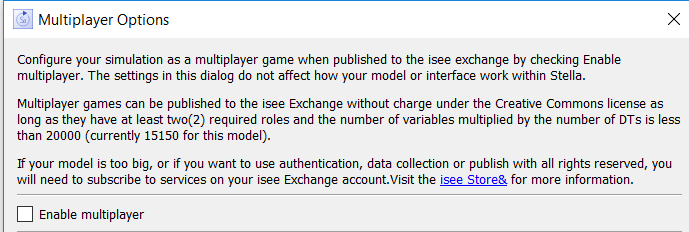
Multiplayer games published in the same way as any other interface (see Publishing to the isee Exchange) but will work differently when published and there for have some restrictions on model size.
To publish a multiplayer game you will need to set up the options for it in the Multiplayer Options dialog.
Multiplayer games run on the server, not in the user's browser. This is necessary because multiple people will be interacting with the model at the same time, and they all need to be seeing the same results (or some part of the same results). As user's make decisions, they are passed to the server and when all the decisions are in, time is advanced in the model and the results reported back to all users. Thus all users are seeing the results of the same model run at the same time.
As long as user's keep playing the game, the model is kept open on the server and runs based on their decisions. If all players leave, the model is closed on the server. If data collection is enabled for the game (see Data Collection) it is possibly to resume a game by have the same player rejoin. In this case, the model is again loaded on the server and then the previous decisions are used to bring it back to the same point in time.
Multiplayer games run on the server, and thus consumer server resources. Because of this, there are restrictions on the size of a model that can be published under the free open access license. This restriction is based on the computational footprint of running the model and is computed as the total number of variables in the model (including expansion of all arrays and macros) multiplied by the total number of time steps. If this number is bigger than 20,000 you will not be able to publish the model under the free license. Larger models require that the server side simulation option under Paid Publishing be used.
When you open the Multiplayer Options dialog it will display the size measurement for your model:

If your model size exceeds the limit, you can decrease it by shortening the run length, increasing DT, or reducing the number of variables.